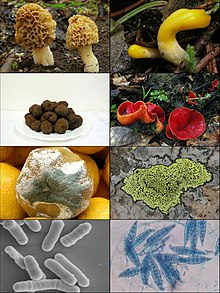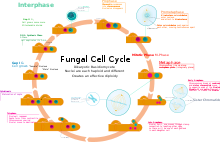
Basidiomycota is one of two large divisions that, together with the Ascomycota, constitute the subkingdom Dikarya within the kingdom Fungi. Members are known as basidiomycetes. More specifically, Basidiomycota includes these groups: agarics, puffballs, stinkhorns, bracket fungi, other polypores, jelly fungi, boletes, chanterelles, earth stars, smuts, bunts, rusts, mirror yeasts, and Cryptococcus, the human pathogenic yeast.

Ascomycota is a phylum of the kingdom Fungi that, together with the Basidiomycota, forms the subkingdom Dikarya. Its members are commonly known as the sac fungi or ascomycetes. It is the largest phylum of Fungi, with over 64,000 species. The defining feature of this fungal group is the "ascus", a microscopic sexual structure in which nonmotile spores, called ascospores, are formed. However, some species of Ascomycota are asexual and thus do not form asci or ascospores. Familiar examples of sac fungi include morels, truffles, brewers' and bakers' yeast, dead man's fingers, and cup fungi. The fungal symbionts in the majority of lichens such as Cladonia belong to the Ascomycota.

A heterokaryon is a multinucleate cell that contains genetically different nuclei. Heterokaryotic and heterokaryosis are derived terms. This is a special type of syncytium. This can occur naturally, such as in the mycelium of fungi during sexual reproduction, or artificially as formed by the experimental fusion of two genetically different cells, as e.g., in hybridoma technology.

The dikaryon(karyogamy) is a nuclear feature that is unique to certain fungi. (The green alga Derbesia had been long considered an exception, until the heterokaryotic hypothesis was challenged by later studies.) Compatible cell-types can fuse cytoplasms (plasmogamy). When this occurs, the two nuclei of two cells pair off and cohabit without fusing (karyogamy). This can be maintained for all the cells of the hyphae by synchronously dividing so that pairs are passed to newer cells. In the Ascomycota this attribute is most often found in the ascogenous hyphae and ascocarp while the bulk of the mycelium remains monokaryotic. In the Basidiomycota this is the dominant phase, with most Basidiomycota monokaryons weakly growing and short-lived.
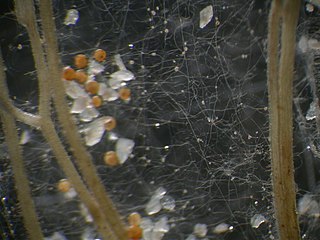
Glomeromycota are one of eight currently recognized divisions within the kingdom Fungi, with approximately 230 described species. Members of the Glomeromycota form arbuscular mycorrhizas (AMs) with the thalli of bryophytes and the roots of vascular land plants. Not all species have been shown to form AMs, and one, Geosiphon pyriformis, is known not to do so. Instead, it forms an endocytobiotic association with Nostoc cyanobacteria. The majority of evidence shows that the Glomeromycota are dependent on land plants for carbon and energy, but there is recent circumstantial evidence that some species may be able to lead an independent existence. The arbuscular mycorrhizal species are terrestrial and widely distributed in soils worldwide where they form symbioses with the roots of the majority of plant species (>80%). They can also be found in wetlands, including salt-marshes, and associated with epiphytic plants.

Saccharomycotina is a subdivision (subphylum) of the division (phylum) Ascomycota in the kingdom Fungi. It comprises most of the ascomycete yeasts. The members of Saccharomycotina reproduce by budding and they do not produce ascocarps.

Aspergillus nidulans is one of many species of filamentous fungi in the phylum Ascomycota. It has been an important research organism for studying eukaryotic cell biology for over 50 years, being used to study a wide range of subjects including recombination, DNA repair, mutation, cell cycle control, tubulin, chromatin, nucleokinesis, pathogenesis, metabolism, and experimental evolution. It is one of the few species in its genus able to form sexual spores through meiosis, allowing crossing of strains in the laboratory. A. nidulans is a homothallic fungus, meaning it is able to self-fertilize and form fruiting bodies in the absence of a mating partner. It has septate hyphae with a woolly colony texture and white mycelia. The green colour of wild-type colonies is due to pigmentation of the spores, while mutations in the pigmentation pathway can produce other spore colours.

Fungi are a diverse group of organisms that employ a huge variety of reproductive strategies, ranging from fully asexual to almost exclusively sexual species. Most species can reproduce both sexually and asexually, alternating between haploid and diploid forms. This contrasts with most multicellular eukaryotes, such as mammals, where the adults are usually diploid and produce haploid gametes which combine to form the next generation. In fungi, both haploid and diploid forms can reproduce – haploid individuals can undergo asexual reproduction while diploid forms can produce gametes that combine to give rise to the next generation.

Taphrina is a fungal genus within the Ascomycota that causes leaf and catkin curl diseases and witch's brooms of certain flowering plants. One of the more commonly observed species causes peach leaf curl. Taphrina typically grow as yeasts during one phase of their life cycles, then infect plant tissues in which typical hyphae are formed, and ultimately they form a naked layer of asci on the deformed, often brightly pigmented surfaces of their hosts. No discrete fruit body is formed outside of the gall-like or blister-like tissues of the hosts. The asci form a layer lacking paraphyses, and they lack croziers. The ascospores frequently bud into multiple yeast cells within the asci. Phylogenetically, Taphrina is a member of a basal group within the Ascomycota, and type genus for the subphylum Taphrinomycotina, the class Taphrinomycetes, and order Taphrinales.

A crozier is an anatomical feature of many fungi in the phylum Ascomycota that forms at the base of asci and looks like a hook-topped shepherd’s staff or stylized religious crosier. Croziers resemble and function similarly to clamp connections on the dikaryotic hyphae of Basidiomycota.

Blastocladiomycota is one of the currently recognized phyla within the kingdom Fungi. Blastocladiomycota was originally the order Blastocladiales within the phylum Chytridiomycota until molecular and zoospore ultrastructural characters were used to demonstrate it was not monophyletic with Chytridiomycota. The order was first erected by Petersen for a single genus, Blastocladia, which was originally considered a member of the oomycetes. Accordingly, members of Blastocladiomycota are often referred to colloquially as "chytrids." However, some feel "chytrid" should refer only to members of Chytridiomycota. Thus, members of Blastocladiomycota are commonly called "blastoclads" by mycologists. Alternatively, members of Blastocladiomycota, Chytridiomycota, and Neocallimastigomycota lumped together as the zoosporic true fungi. Blastocladiomycota contains 5 families and approximately 12 genera. This early diverging branch of kingdom Fungi is the first to exhibit alternation of generations. As well, two (once) popular model organisms—Allomyces macrogynus and Blastocladiella emersonii—belong to this phylum.

Fungi diverged from other life around 1.5 billion years ago, with the glomaleans branching from the "higher fungi" (dikaryans) at ~570 million years ago, according to DNA analysis. Fungi probably colonized the land during the Cambrian, over 500 million years ago,, and possibly 635 million years ago during the Ediacaran, but terrestrial fossils only become uncontroversial and common during the Devonian, 400 million years ago.

A fungus is any member of the group of eukaryotic organisms that includes microorganisms such as yeasts and molds, as well as the more familiar mushrooms. These organisms are classified as one of the traditional eukaryotic kingdoms, along with Animalia, Plantae, and either Protista or Protozoa and Chromista.
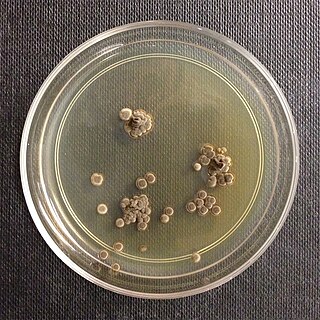
The Wallemiomycetes are a class of fungi in the division Basidiomycota. It consists of the single order Wallemiales, containing the single family Wallemiaceae, which in turn contains the single genus Wallemia. The phylogenetic origin of the lineage was placed to various parts of Basidiomycota, but according to the analysis of a larger dataset it is a sister group of Agaricomycotina. The genus contains species of xerophilic molds that are found worldwide. The seven described species are distinguished by conidial size, xerotolerance, halotolerance, chaotolerance, growth temperature regimes, extracellular enzyme activity profiles, and secondary metabolite patterns. They are typically isolated from low-moisture foods, indoor air dust, salterns and soil. W. sebi is thought to be one of the causes of the hypersensitivity pneumonitis known as the farmer's lung disease, but since the other species were recognised and separated from W. sebi only recently, their role in the disease cannot be excluded.
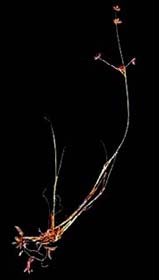
Entorrhizomycetes is the sole class in the phylum Entorrhizomycota, within the Fungi subkingdom Dikarya along with Basidiomycota and Ascomycota. It contains three genera and is a small group of teliosporic root parasites that form galls on plants in the Juncaceae (rush) and Cyperaceae (sedge) families. Prior to 2015 this phylum was placed under the subdivision Ustilaginomycotina. A 2015 study did a "comprehensive five-gene analyses" of Entorrhiza and concluded that the former class Entorrhizomycetes is possibly either a close sister group to the rest of Dikarya or Basidiomycota.

Holomycota or Nucletmycea are a basal Opisthokont clade as sister of the Holozoa. It consists of the Cristidiscoidea and the kingdom Fungi. The position of nucleariids, unicellular free-living phagotrophic amoebae, as the earliest lineage of Holomycota suggests that animals and fungi independently acquired complex multicellularity from a common unicellular ancestor and that the osmotrophic lifestyle was originated later in the divergence of this eukaryotic lineage. Opisthosporidians is a recently proposed taxonomic group that includes aphelids, Microsporidia and Cryptomycota, three groups of endoparasites.

The fungi imperfecti or imperfect fungi are fungi which do not fit into the commonly established taxonomic classifications of fungi that are based on biological species concepts or morphological characteristics of sexual structures because their sexual form of reproduction has never been observed. They are known as imperfect fungi because only their asexual and vegetative phases are known. They have asexual form of reproduction, meaning that these fungi produce their spores asexually, in the process called sporogenesis.

Mucoromycota is a division within the kingdom fungi. It includes a diverse group of various molds, including the common bread molds Mucor and Rhizopus. It is a sister phylum to Dikarya.

Amastigomycota or Eufungi is a clade of fungi. It includes all fungi without flagella or centrioles, and with unstacked Golgi apparatus cisternae. Members of this clade are Dikarya and the traditional paraphyletic assemblage "Zygomycota", now divided into several monophyletic phyla.

